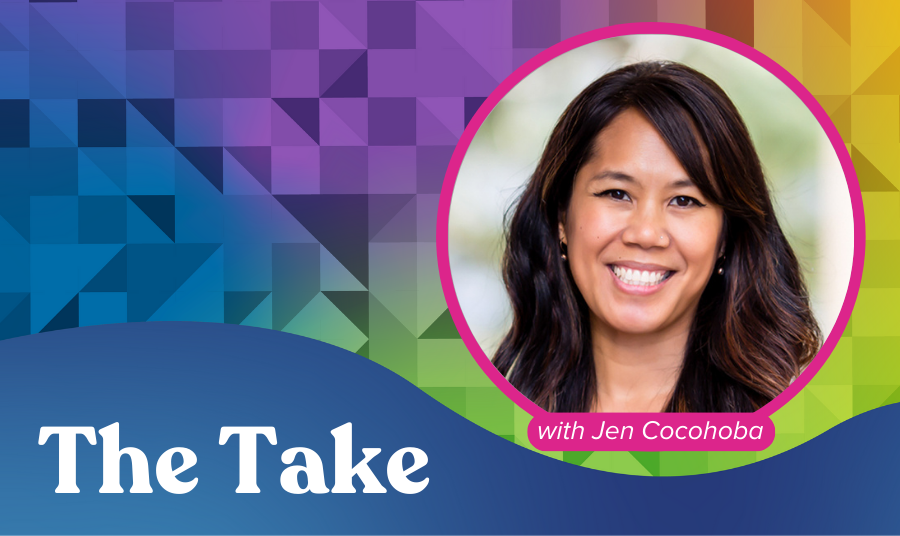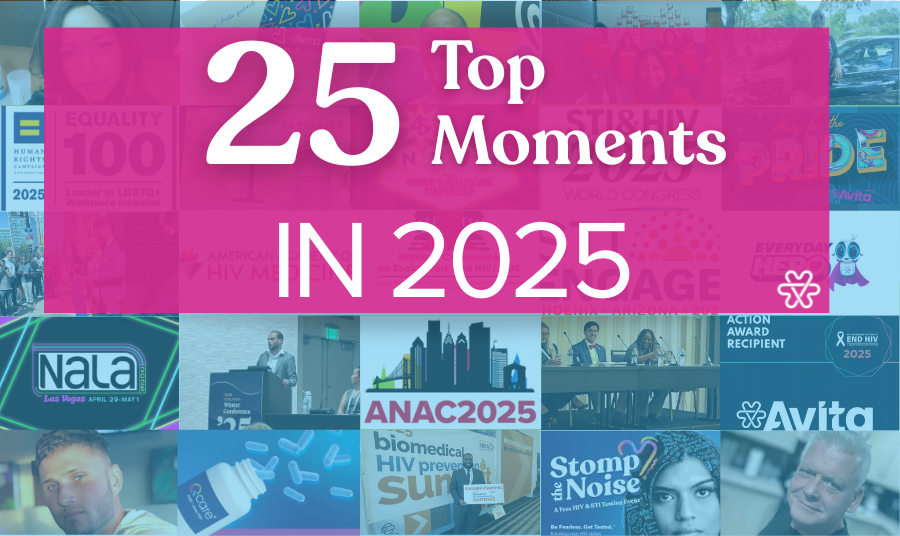A series of seminal public health events—from the 40-plus year HIV/AIDS epidemic to the more recent COVID crisis—have expanded the vital role community pharmacists play as change agents dedicated to a better patient journey. In this edition of “The Take,” Avita Chief Advocacy Officer Glen Pietrandoni talks to renowned clinical pharmacist, researcher, and author Jennifer Cocohoba about how far these pharmacists have come as integrated members of our nation’s health care teams, and why—in a nation with an ever-increasing swath of pharmacy deserts—that momentum is more important than ever.
GLEN: Jen, we’ve known each other for years. In 2012, we partnered on an article about the impact of HIV-specialized pharmacies on adherence to antiretroviral therapy. Let’s talk about how far pharmacists have come since then. In California, SB 159 allows pharmacists to offer PEP (post-exposure prophylaxis) and PrEP (pre-exposure prophylaxis) without a physician’s prescription, and there’s a national movement to give greater prescribing authority to pharmacists to help end HIV and health inequities. Can you describe the journey as the health care industry is realizing the true value of pharmacists as crucial community caregivers?
JEN: Pharmacists were thrown into the beginning of the HIV epidemic just like all health care providers. It was an all-hands-on-deck situation. They joined the fight to care for those with HIV/AIDS because their patients were standing right in front of them with questions about their medicines.
Flash forward to today, and pharmacists have come quite a long way, from focusing strictly on the medicines to concentrating more on the holistic services being offered to patients living with HIV. I remember back in the day, it was a big deal for pharmacists to put meds in blister packs to help patients keep track of them, and now that’s sort of routine. Of course, pharmacists still offer helpful adherence packaging and delivery, but we’re really looking beyond that: How do we improve the general health of people living with HIV, not only through their medicines but also with other services like immunizations or the treatments of the future?
Pharmacists must also recognize that, when it comes to HIV, each local area has a different culture around the epidemic. It’s the job of local health care providers to understand the patient experience in their areas and adapt their care to meet the needs of what’s going on right then, right there in that geographic area.
When it comes to HIV, each local area has a different culture around the epidemic. It’s the job of local health care providers to understand the patient experience in their areas and adapt their care to meet the needs of what’s going on right then, right there in that geographic area.
Jen Cocohoba, PharmD, AAHIVP, FCSHp
Pharmacists are playing a central role in the fight to end HIV
GLEN: California passed SB 159 in 2019. Can you speak about how that is impacting the fight against HIV?
JEN: In the old days, pharmacists were just trying to support patients through oral HIV treatments. We were definitely not at our best in terms of meds back then; I can remember when it seemed like we were dispensing 16 football-sized tablets for just one HIV regimen component. It was terrible.
Science has advanced so rapidly. Now, we’re not only talking about how to best treat HIV but also how we prevent it. We’ve got oral PrEP and even injections once every two months to prevent HIV.
It makes sense that the pharmacist should be a central point of PrEP delivery for patients. We’re already the last to touch the medicine before it goes to them. It’s exciting to see bills rolling across other states that duplicate California’s SB 159. We’re allowing pharmacists to play a central role in providing the medications that potentially could end the HIV epidemic.
We’re allowing pharmacists to play a central role in providing the medications that potentially could end the HIV epidemic.
JEN COCOHOBA, PHARMD, AAHIVP, FCSHP
Pharmacies as hubs for long-acting HIV prevention and treatment delivery
GLEN: You’re currently engaged in a clinical trial that revolves around pharmacy-based delivery of long-acting injectable antiretroviral therapy (LAI-ART). Can you tell me a bit about that?
JEN: Science has shown that PrEP is a highly effective way of preventing HIV. Yet the latest reports show that only 36% of people who could benefit from PrEP are taking it. So, we have a way to go if we want to utilize PrEP to stop the transmission of HIV. One of the avenues for doing that is to make PrEP more accessible. Another way is to improve the technologies by which we deliver it. Long-acting PrEP and HIV treatment options are the wave of the future. As pharmacists, we must think about how they fit into our care delivery models.
My research focuses on opportunities for community pharmacies to take a lead in serving as “differentiated care sites,” or another place where people can receive long-acting HIV medications for treatment or prevention. The goal of my research is to study the attitudes of health care providers, patients, and pharmacists about this, and it’s really interesting. There’s not just one way to deliver these therapies; we have to propose multiple ways. Patients should have a choice. Preliminary findings from the study show that people seem to be very open to the idea of pharmacists administering long-acting injectable HIV medication, whether it’s for treatment or for prevention.
But there are a lot of concerns about implementation. Where are patients going to get their shots? What will the communication between pharmacists, patients, and providers look like? What are the privacy concerns? What about labs, reimbursement, and staffing? We’re hearing clinician providers worry about the scope of practice.
But I’m also hearing clinics say they either don’t have the resources to get started (offering long-acting injectables) or that they’re having difficulty obtaining these medicines and creating their own delivery systems. They’re asking themselves, “How do we get these medicines out to a bigger group of patients?”
So overall, there’s a need for pharmacists to play a central role. It can’t be ignored that pharmacies are another place where these medicines can be delivered.
Long-acting PrEP and HIV treatment options are the wave of the future. As pharmacists, we must think about how they fit into our care delivery models.
JEN COCOHOBA, PHARMD, AAHIVP, FCSHP
Why serving marginalized populations all boils down to garnering trust
GLEN: The data speaks for itself: There’s a disparity in the burden of HIV, and it falls with marginalized, stigmatized, and rural communities. As the clinical pharmacist at University of California, San Francisco (UCSF) Womens’ HIV Program, you optimize antiretroviral therapy, patient adherence, chronic disease management, and opioid stewardship. What interventions/forms of engagement are working to help these groups, such as women of color, buy into using PrEP or staying adherent to their medications if they’re living with HIV? Once again, how does the community pharmacist play a role?
JEN: There are so many different groups with different needs. One of the things I’ve learned over time is that it’s all about building relationships. It all boils down to, are you able to form a dynamic with a patient that garners trust and the potential for lifelong care?
This is a crucial part of the thinking behind how we train future pharmacists. Many pharmacy schools are, as always, trying to keep up with the most advanced therapeutics and ensure that their students are knowledgeable about the latest medications used to treat chronic disease states. But pharmacy schools also are realizing they need to help students learn how to build relationship-centered communications.
There’s a fair amount of focus in schools on interviewing, communication skills, conflict resolution, and leadership training. We need to create a generation of pharmacy students that are ready to take on whatever’s coming their way, whether it’s a global pandemic or simply changes and expansions in pharmacy’s scope of practice.
We need to create a generation of pharmacy students that are ready to take on whatever's coming their way, whether it's a global pandemic or simply changes and expansions in pharmacy’s scope of practice.
JEN COCOHOBA, PHARMD, AAHIVP, FCSHP
Pharmacy deserts, the impact of climate change on health equity, and those left behind
GLEN: You just co-authored a very timely article about how communities are being negatively affected by “pharmacy deserts,” which have been exacerbated by the extreme weather events we’ve seen due to climate change. Tell me about your study and what you and your co-authors have suggested in terms of future research and policy changes.
JEN: The simple explanation for my involvement in that project is that I really like maps; I find them fascinating. But seriously, the article was based on the idea that we always tout the pharmacist as being the most accessible health care provider. You know, “There’s a store around every corner, and every person has a pharmacist.” But that’s not necessarily true for everybody. As we move out of the COVID-19 pandemic, we are seeing the closure of more than 1,500 retail pharmacies for a variety of economic and market-based issues.
We’re also seeing that these pharmacy deserts are more common in neighborhoods of lower socioeconomic status. To live close to a pharmacy should not be an elitist privilege. Everybody should have access to medications and their local pharmacist.
The additional layer to all this is that there have been further pharmacy closures due to extreme weather events. Think about it: What happens if there’s just one pharmacy that services a very large area, and then it’s impacted by a natural disaster? These communities are vulnerable to begin with. The lack of pharmacies is just another point of vulnerability we need to be aware of so we can plan how to support these areas in the event of something unexpected like a natural disaster. It’s a two-pronged approach: Pharmacies can do as much as possible to be prepared, but we also have to offer points of education to our patients so that they can be ready in an emergency.
To live close to a pharmacy should not be an elitist privilege. Everybody should have access to medications and their local pharmacist.
JEN COCOHOBA, PHARMD, AAHIVP, FCSHP
Pharmacy whiplash
GLEN: Health experts are already citing the fallout for marginalized patients as a result of pharmacy closings. Let’s talk about the impact on community pharmacists. The Washington Post referred to the entire situation as “pharmacy whiplash.”
JEN: The blight of pharmacy deserts puts a lot of pressure on community pharmacists and the profession as a whole. The pharmacies that remain near the impacted service areas have to figure out how to facilitate relationships with patients that may not live nearby. They need to address practical issues like expanding their capacity to fill more prescriptions and support peoples’ ability to physically get their medications and immunizations while traveling far distances.
I’m glad this problem is getting more media attention. Communities, corporations, and other stakeholders need to understand how central the local pharmacist is to the health of a neighborhood—and grasp the potentially dire consequences when one disappears.
Communities, corporations, and other stakeholders need to understand how central the local pharmacist is to the health of a neighborhood—and grasp the potentially dire consequences when one disappears.
JEN COCOHOBA, PHARMD, AAHIVP, FCSHP
Advice for the next generation of pharmacists
GLEN: At UCSF, you serve as a mentor for pharmacy students who are coming up in an environment where they’re faced with multiple epidemics, vastly unserved patient populations, and ever-changing policies and interventions from drug manufacturers, payors, and legislators. Beyond best practices in clinical training, what advice are you offering your students to help them successfully navigate this world while serving their patients with dignity and respect?
JEN: One thing I always tell my students is to keep their options open. The profession of pharmacy is so wide, whether they decide to take their first position within a hospital system, a community pharmacy, the pharmaceutical industry, or another area. Our early-year students often think, “I’m going to be this. This is what I’m going to do.” Then by the time they reach their third or fourth year, they’ve changed their minds.
That’s not a bad thing. While you’re in pharmacy school and have that safety net, try it all, see what you like, see what really resonates with you. Don’t have such a fixed mindset of what you think you’re going to do.
GLEN: When I was in pharmacy school in the 70s, one of my rotations was working with cancer patients, fitting them for ostomy bags and things like that. And I thought, “I want no part of this.” But everything I learned during that rotation, especially about stigma and sensitivity, I used in my future practice. You don’t even know you’re learning when you’re learning sometimes.
While you're in pharmacy school and have that safety net, try it all, see what you like, see what really resonates with you. Don't have such a fixed mindset of what you think you're going to do.
JEN COCOHOBA, PHARMD, AAHIVP, FCSHP
What’s your take? Whether you have an idea for a future guest or topic for our series or would like to comment on the insights of one of our past guests, we’d love to hear from you! Reach out to us at [email protected].
ABOUT JEN COCOHOBA, PharmD, AAHIVP, FCSHP:
Jen is co-vice dean of clinical innovation and entrepreneurship, vice chair of faculty development in the Department of Clinical Pharmacy, and a professor of clinical pharmacy at the University of California, San Francisco (UCSF) School of Pharmacy. She serves as the clinical pharmacist for the UCSF Womens HIV Program (WHP), where she conducts HIV regimen and drug interaction consultations, medication therapy and chronic disease management, adherence counseling, opioid stewardship, and clinic-wide quality improvement initiatives. She also serves as a faculty advisor and research mentor for the Mabuhay Health Center, a UCSF student-run free clinic.
Jen’s research focuses on pharmacoepidemiology, medication use in persons living with HIV, interventions to improve medication adherence for chronic diseases, and implementation of novel models of health care delivery in pharmacies.
ABOUT GLEN PIETRANDONI:
Glen is chief advocacy officer at Avita Care Solutions, an award-winning pharmacy leader, passionate 340B program advocate, and internationally respected HIV and LGBTQ+ activist. He’s deeply engaged in Avita’s mission to advocate for health equity and the 340B Drug Pricing program and works to bring together stakeholders from the pharmaceutical industry and patient advocacy arenas. Through webinars, conferences, Avita’s thought leadership blog series “The Take,” and the organization’s engagement with multiple community and trade associations, Glen leads Avita’s educational and awareness efforts and acts as a voice for its covered entity partners and patients. He continually fights for continued access to the 340B program and advances stigma-free HIV, PrEP, LGBTQ+, and sexual wellness care for underserved patient populations.
Glen recently received Pharmacy Times’ Lifetime Leadership honor at the Next-Generation Pharmacist awards. He serves on the Board of Pharmacy for the State of Illinois, was formerly chairman of the Board of Trustees of AIDS United, and sits on the board of Community Voices for 340B (CV340B). He has earned American Academy of HIV Medicine and Apexus 340B certifications.




